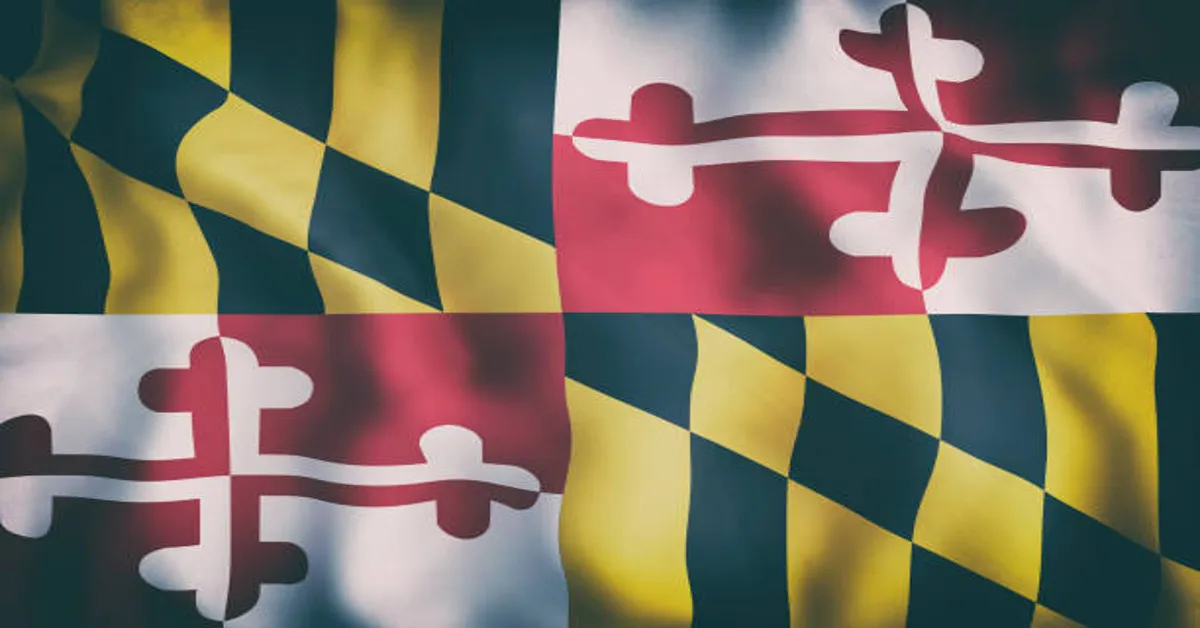The Maryland state flag is often considered one of the most unique and visually striking flags in the United States. Unlike most state flags, which typically feature a seal on a blue background, Maryland’s flag stands out with its bold pattern of red, white, black, and gold. At first glance, the design appears almost medieval, a mix of symmetry and heraldry not commonly seen in modern vexillology. Yet, beyond its design lies a story rich with heritage, deep political meaning, and historical evolution. This article provides a thorough and informative look into the origins, significance, evolution, and enduring identity of the Maryland flag. Whether you’re a lifelong resident, new visitor, student, or history enthusiast, understanding the Maryland flag offers a window into the complex and fascinating history of the state itself.
The Origins: A Flag Rooted in Heraldry and Family Legacy
To understand the Maryland flag, one must first become acquainted with the historical figures that inspired its creation—specifically, George Calvert, the first Lord Baltimore. In the 1600s, George Calvert, an English nobleman, was granted a coat of arms by King James I. This coat of arms would later become the foundation for what we recognize today as the Maryland flag. The flag is not a random design, but a direct representation of Calvert’s heraldic symbols, which blend both sides of his family heritage.
George Calvert’s personal coat of arms consisted of two parts—one part represented his paternal family, the Calverts, and the other represented his maternal lineage, the Crosslands. The gold and black chevrons symbolize the Calvert family, while the red and white cross bottony belongs to the Crossland family. These two heraldic elements became fused together as a statement of personal lineage, and later, political unity.
Design Breakdown: Understanding Each Quadrant of the Flag
The Maryland flag is divided into four quadrants, alternating in color and pattern. The design is symmetrical, with diagonally opposing quadrants sharing the same design.
- Calvert Colors (Gold and Black Chevrons): These appear in the first and fourth quarters (top left and bottom right). The alternating gold and black patterns form a “paly of six” pattern with a diagonal stripe known as a “bend.” The combination suggests strength, stability, and leadership, qualities attributed to the Calvert family during colonial times.
- Crossland Colors (Red and White Cross Bottony): These fill the second and third quarters (top right and bottom left). The cross bottony, named for its trefoil or “button-like” ends, is symbolic of Christian faith and noble origin. The red and white contrast sharply with the gold and black, creating a vibrant interplay of colors.
This four-part layout is unique among U.S. state flags and deeply symbolic, representing both individual identity and broader unity.
The Civil War Influence: A Flag Divided and Later United
Maryland’s identity during the Civil War was a conflicted one. As a border state with strong ties to both the North and the South, it was caught between two opposing political and military ideologies. Though Maryland never officially seceded from the Union, it had a significant number of citizens who sympathized with the Confederacy.
The Calvert side of the flag—black and gold—was used by Union loyalists and remained associated with the state government, which sided with the North. In contrast, the red and white Crossland colors were adopted by Confederate sympathizers and soldiers. Each half of the flag became a silent signal of allegiance during a time of intense internal division.
Following the end of the war, as the country entered a period of Reconstruction and reconciliation, Maryland faced the challenge of reuniting its people. In an act of symbolic unity, the state began to combine both heraldic banners into a single flag. What was once a sign of division evolved into a symbol of reconciliation and shared identity.
This union of opposing symbols into one cohesive design is perhaps the most profound aspect of the Maryland flag. It doesn’t ignore the state’s troubled history—it embraces it and uses it as a platform for progress and unity.
Official Recognition and Adoption as State Flag
While the flag design had been used informally throughout the late 19th century, it wasn’t until 1904 that the Maryland General Assembly officially adopted it as the state flag. The legislation recognized the flag not only for its visual distinction but for its historical and cultural value. It was described as a “distinctive and appropriate emblem of the State.”
This formal recognition solidified its place in Maryland identity and civic life. From that point onward, the flag became a central feature in schools, government buildings, and public ceremonies. It was proudly displayed during state holidays, military parades, and other events that called for state representation.
Symbolism and Meaning in Modern Context
Today, the Maryland flag represents more than just historical lineage. It has come to symbolize resilience, pride, diversity, and unity among Marylanders. Each quadrant of the flag serves as a visual reminder that identity is complex, shaped by both conflict and cooperation.
The flag has also become a symbol of inclusiveness and civic pride. Whether it’s worn on apparel, flown at sporting events, or used in branding, the flag is instantly recognizable and evokes strong emotional attachment from residents.
It’s not just about what the flag looked like historically—it’s about what it has come to mean: that Maryland, as a state, values its history, honors its differences, and stands united despite its past divisions.
Influence on State Identity and Culture
Maryland’s flag is more than a government emblem—it is deeply woven into the cultural fabric of the state. You’ll find the flag on everything from license plates and university merchandise to sports uniforms and brewery logos. It’s a symbol embraced by locals with enthusiasm and pride.
At sports events, especially University of Maryland games, fans often wear the flag as capes, hats, shirts, and face paint. The Baltimore Ravens and the Maryland Terrapins regularly use the flag in their branding, capitalizing on its bold design and widespread recognition.
The flag has become a motif in art, architecture, and public displays. Murals of the flag appear in Baltimore, Annapolis, and smaller towns alike. Local businesses frequently incorporate the design into their signs or packaging, making it a unifying element of commercial and civic life.
Educational Use and State Curriculum
The flag also plays a role in Maryland’s educational system. Students in elementary and middle school often learn about the state’s symbols as part of their social studies curriculum. Lessons about the flag include its historical origins, meaning, and role during the Civil War. These lessons foster an early sense of state pride and help students understand the importance of symbols in representing community and governance.
In some classrooms, students are asked to draw the flag or create reports that explain the significance of each quadrant. This not only teaches historical context but reinforces visual literacy and civic identity. School buildings often fly the flag alongside the national flag, creating daily visual reinforcement of state pride.
Protocols for Display and Use
The Maryland flag, like the national flag, is subject to specific guidelines regarding its display. According to state protocol:
- The flag should always be treated with respect.
- When flown with the U.S. flag, the national flag should take precedence.
- The Maryland flag should be displayed prominently on state holidays, especially Maryland Day (March 25).
- Flags flown at half-mast should follow the same guidelines as the U.S. flag for periods of mourning.
These protocols are observed in government institutions and are often encouraged in educational settings as well.
Common Misconceptions
Because of its unusual design, the Maryland flag often causes confusion for those unfamiliar with its background. Some believe it to be a colonial or foreign flag due to its heraldic style. Others mistake the cross bottony for religious symbolism without understanding the familial origin.
Another common misconception is that the flag has religious affiliations, but in reality, the design is rooted in English nobility and personal lineage rather than ecclesiastical intent.
Understanding the actual origins helps dispel these myths and fosters a deeper appreciation for the flag’s true meaning and purpose.
Preservation and Modern Design Standards
To maintain the integrity of the flag’s unique design, official state publications provide precise color codes and design proportions. These standards ensure that regardless of medium—print, digital, textile—the flag retains its visual identity and complies with legal definitions.
- Color Codes: The gold and red must match specified Pantone values to avoid distortion.
- Dimensions: The flag must maintain a 2:3 ratio.
- Usage Restrictions: The flag should not be altered, defaced, or used inappropriately in advertising.
These standards are particularly important in government printing, tourism materials, and licensing.
Conclusion: A Flag That Represents More Than a State
The Maryland flag stands as a powerful example of how symbols can evolve from personal history to represent collective identity. From its heraldic origins rooted in English nobility to its unifying role post-Civil War, the flag tells a layered story of resilience, duality, and integration.
More than just a visual design, the Maryland flag is a conversation piece, a cultural artifact, and a beacon of unity. It acknowledges the complexities of history while offering a bold and distinctive symbol of state pride. Its use in public, private, and artistic domains reaffirms its place not only as a state flag but as a cultural icon.
ALSO READ: Bright Spot iPad Pro: Understanding the Issue, Causes, and Practical Solutions
Frequently Asked Questions (FAQs)
1. What do the colors and patterns on the Maryland flag represent?
The black and gold chevrons represent the Calvert family, while the red and white cross bottony comes from the Crossland family, both of which are part of George Calvert’s coat of arms.
2. Why is the Maryland flag divided into four parts?
The four-part division unites the Calvert and Crossland family symbols, reflecting both Maryland’s noble lineage and post-Civil War reconciliation between Union and Confederate sympathizers.
3. Was the Maryland flag used during the Civil War?
The Calvert (black and gold) portion was used by Union supporters, while the Crossland (red and white) section was favored by Confederate sympathizers. The combined flag emerged as a unifying symbol after the war.
4. When did the Maryland flag become the official state flag?
The flag was officially adopted by the Maryland General Assembly in 1904, although it had been in informal use for decades before that.
5. Why is the Maryland flag so popular in culture and sports?
Its bold colors and unique design make it visually appealing, while its deep historical roots foster strong state pride, leading to widespread use in branding, merchandise, and fan gear.









